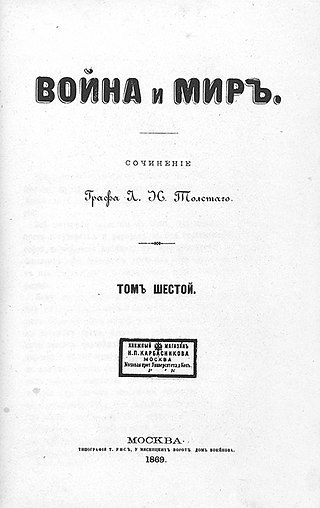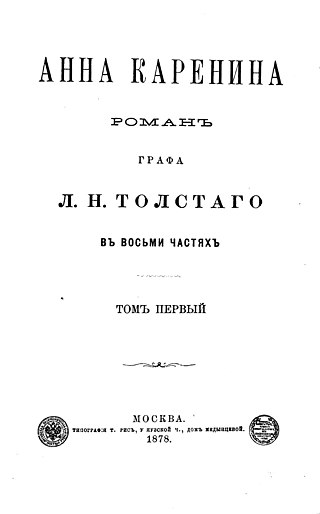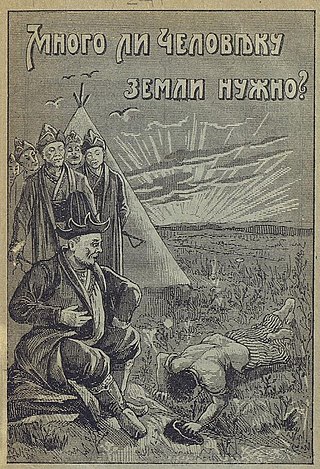
War and Peace is a literary work by Russian author Leo Tolstoy. Set during the Napoleonic Wars, the work mixes fictional narrative with chapters discussing history and philosophy. First published serially beginning in 1865, the work was rewritten and published in its entirety in 1869. It is regarded as Tolstoy's finest literary achievement and remains an internationally praised classic of world literature.

Anna Karenina is a novel by the Russian author Leo Tolstoy, first published in book form in 1878. Considered to be one of the greatest works of literature ever written, Tolstoy himself called it his first true novel. It was initially released in serial installments from 1875 to 1877, all but the last part appearing in the periodical The Russian Messenger. When William Faulkner was asked to list what he thought were the three greatest novels, he replied: "Anna Karenina, Anna Karenina, and Anna Karenina".

The Tolstoyan movement is a social movement based on the philosophical and religious views of Russian novelist Leo Tolstoy (1828–1910). Tolstoy's views were formed by rigorous study of the ministry of Jesus, particularly the Sermon on the Mount.
What Is Art? is a book by Leo Tolstoy. It was completed in Russian in 1897 but first published in English due to difficulties with the Russian censors.
Confession, or My Confession, is a short work on the subject of melancholia, philosophy and religion by the Russian novelist Leo Tolstoy. It was written in 1879 to 1880, when Tolstoy was in his early fifties.

"Ivan the Fool" is an 1886 short story by Leo Tolstoy, published in 1886. The name "Ivan the Fool" alludes to a popular hero of Russian folklore.

"How Much Land Does a Man Require?" is an 1886 short story by Leo Tolstoy about a man who, in his lust for land, forfeits everything.

Aylmer Maude and Louise Maude (1855–1939) were English translators of Leo Tolstoy's works, and Aylmer Maude also wrote his friend Tolstoy's biography, The Life of Tolstoy. After living many years in Russia the Maudes spent the rest of their lives in England translating Tolstoy's writing and promoting public interest in his work. Aylmer Maude was also involved in a number of early 20th century progressive and idealistic causes.
"What Men Live By" is a short story written by Russian author Leo Tolstoy in 1885. It is one of the short stories included in his collection What Men Live By, and Other Tales, published in 1885. The compilation also included the written pieces "The Three Questions", "The Coffee-House of Surat", and "How Much Land Does a Man Need?".
Promoting a Devil is a short story by Russian author Leo Tolstoy first published in 1886.. It is a cautionary tale story about a man who fell into a sinful life when he was given more than he needed.
"Repentance" is a short story by Russian author Leo Tolstoy first published in 1886. The story details the difficulties of a repentant sinner's attempts to enter Heaven.
"God Sees the Truth, But Waits" is a short story by Russian author Leo Tolstoy first published in 1872. The story, about a man sent to prison for a murder he did not commit, takes the form of a parable of forgiveness. English translations were also published under titles "The Confessed Crime", "Exiled to Siberia", and "The Long Exile". The concept of the story of a man wrongfully accused of murder and banished to Siberia also appears in one of Tolstoy's previous works, War and Peace, during a philosophical discussion between two characters who relate the story and argue how the protagonist of their story deals with injustice and fate. Along with his story The Prisoner of the Caucasus, Tolstoy personally considered this work to be his only great artistic achievement.

"Croesus and Fate" is a short story by Leo Tolstoy that is a retelling of a Greek legend, classically told by Herodotus, and Plutarch, about the king Croesus. It was first published in 1886 by Tolstoy's publishing company The Intermediary. Tolstoy's version is shorter than that by Herodotus, and Tolstoy's characterization of Croesus was designed to parallel the title character in his 1886 novella The Death of Ivan Ilych.
"The Grain" or "A Grain As Big As A Hen's Egg" is an 1886 short story by Leo Tolstoy about a king seeking to understand the properties of a grain he acquires.

"Three Deaths: A Tale" is a short story by Leo Tolstoy first published in 1859. It narrates the deaths of three subjects: a noblewoman, a coachman and a tree.
"The Three Hermits" is a short story by Russian author Leo Tolstoy written in 1885 and first published in 1886 in the weekly periodical Niva (нива). It appeared in the short-story collection Twenty-Three Tales which was first translated into English for an edition released by Funk & Wagnalls in 1907. The title refers to its three central characters; unnamed simple monks living on a remote island in a life of prayer and contemplation "for the salvation of their souls."
"The Coffee-House of Surat" is a short story by Leo Tolstoy written in 1891, first published in Russian in 1893, and first published in English in 1901. Like several other of Tolstoy's works, this work is based on a French piece translated by Tolstoy himself, by Jacques-Henri Bernardin de Saint-Pierre. Due to the censorship in Russia, Tolstoy had to adjust the tale somewhat.
"The Godson" is a short story by Leo Tolstoy published in 1886. Inessa Medzhibovskaya, professor of English at New School for Social Research, describes the short story as the tale of a godson who is forbidden to open a certain sealed room in his godfather's palace, but then opens it and is banished, leading to his need for redemption.
"Esarhaddon, King of Assyria" is a short story by Leo Tolstoy written in 1903. Tolstoy wrote it as part of an anthology dedicated to the victims of the Kishinev pogrom in Russia, with all of the proceeds going to a relief fund. It is the story of a king who oppresses his subjects.
Twenty-Three Tales is a popular compilation of short stories by Leo Tolstoy. According to its publisher, Oxford University Press, the collection is about contemporary classes in Russia during Tolstoy's time, written in a brief, morality-tale style. It was translated into English by Louise Maude and Aylmer Maude.








